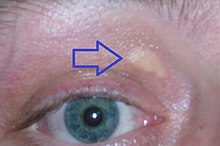Xanthelasma
| Classification according to ICD-10 | |
|---|---|
| H02.6 | Xanthelasma palpebrarum |
| ICD-10 online (WHO version 2019) | |
In Xanthelasmen (from Greek ξανθός (xanthos) = yellow and τὸ ἔλασμα (elasma) = the board) is, to yellow or red, sharply defined deposits of fat or fatty substances ( cholesterol ) in the skin . Often the xanthelasma appearing on both halves of the face is found above the eyes on the nasal side of the eyelids ( Xanthelasma palpebrarum ).
treatment
Xanthelasma does not usually resolve and cannot be treated with medication. One possible therapy is the external application of strongly corrosive substances such as trichloroacetic acid . Surgical removal is also performed; but there is a risk of scarring. The laser surgery is the most widely-applied process for removing Xanthelasmen. The laser removes the affected areas of skin superficially. Since all treatment methods only aim to remove the affected areas of skin, but do not address the (largely unknown) causes, there is a high likelihood of relapse. According to a study from 1979 it is 40% with surgical treatment; if a relapse has already occurred and this has been surgically removed, the probability of relapse is as high as 60%. This means that in 24% of the patients treated, the xanthelasma return even after being removed twice. However, it usually takes several years for them to return.
Since xanthelasma are neither contagious nor impair the physical condition of those affected, statutory health insurance companies do not cover the costs for their removal. Those affected often feel stigmatized because a pronounced clinical picture gives the optical impression of "scarred" eyes. Study data suggest that these lipid deposits should be viewed as indicators of an increased cardiovascular risk, regardless of blood lipid levels .
causes
Xanthelasma can be the expression of a lipid metabolism disorder ( e.g. hypercholesterolemia ) or primary biliary cholangitis (PBC), but they also occur in healthy people. Occasionally, after drug lowering of elevated blood lipid levels, there is also an accompanying regression of the xanthelasma. The main risk groups are older men with disorders of the lipid metabolism as well as women beyond menopause . Xanthelasma is rare in adolescents.
to form
- flat xanthelasma (Xanthelasma planum)
- raised Xanthelasma (Xanthelasma tuberosum)
Individual evidence
- ^ TR Nahas, JC Marques, A. Nicoletti, M. Cunha, MC Nishiwaki-Dantas, JV Filho: Treatment of eyelid xanthelasma with 70% trichloroacetic acid. In: Ophthal Plast Reconstr Surg. Volume 25, No. 4, Jul-Aug 2009, pp. 280-283.
- ↑ Xanthelasma indicates cardiovascular risk. In: Deutsches Ärzteblatt. September 16, 2011.
- ↑ M. Christoffersen, R. Frikke-Schmidt, P. Schnohr, GB Jensen, BG Nordestgaard, A. Tybjærg-Hansen: Xanthelasmata, arcus corneae, and ischaemic vascular disease and death in general population: prospective cohort study. In: BMJ (Clinical research ed.). Volume 343, 2011, p. D5497. PMID 21920887 , PMC 3174271 (free full text).
- ^ Sue Hughes: Xanthelasmata predictive of cardiovascular events . September 19, 2011, accessed October 4, 2016.

